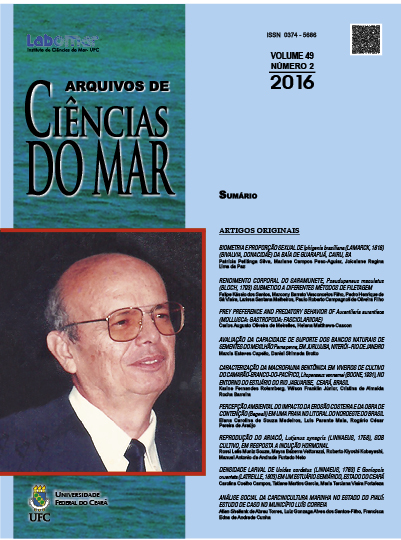Larval density of Ucides cordatus (Linnaeus, 1763) and Goniopsis cruentata (Latreille, 1803) in a semiarid estuary, Ceará State
DOI:
https://doi.org/10.32360/acmar.v49i2.6583Keywords:
Aratu, uçá, meroplankton, estuarine environment.Abstract
The estuarine zooplankton community is potentially limited by the currents, which can export these organisms to the marine environment. Brachyuran species use this movement of water as a survival strategy in the early stages of life. This study aimed to quantify the larval zoea I of crabs Ucides cordatus and Goniopsis cruentata in Jaguaribe River estuary by means of samples taken during the dry season, in July – September of 2007, and during the rainy season, in March – May of 2008, a day before the occurrence of spring tide (new moon). The larvae were collected in the tidal ebb and flow through subsurface horizontal hauls with net 300 μm. During dry season, were found only zoea I of G. cruentata with a density of 148,0 ± 370,7 ind./m³. In the rainy season, we found larvae of both species, with U. cordatus showing a density of 2806,8 ± 11381,8 ind./m³ and G. cruentata, density of 1569,8 ± 5635,9 ind./m³. The highest densities occurred at ebb tide, indicating that the larvae leave the estuary.Downloads
Published
2017-05-05
Issue
Section
Artigos originais
License
1. Proposta de Política para Periódicos de Acesso Livre
Autores que publicam nesta revista concordam com os seguintes termos:
- Autores mantém os direitos autorais e concedem à revista o direito de primeira publicação, com o trabalho simultaneamente licenciado sob a Licença Creative Commons Attribution que permite o compartilhamento do trabalho com reconhecimento da autoria e publicação inicial nesta revista.
- Autores têm autorização para assumir contratos adicionais separadamente, para distribuição não-exclusiva da versão do trabalho publicada nesta revista (ex.: publicar em repositório institucional ou como capítulo de livro), com reconhecimento de autoria e publicação inicial nesta revista.
- Autores têm permissão e são estimulados a publicar e distribuir seu trabalho online (ex.: em repositórios institucionais ou na sua página pessoal) a qualquer ponto antes ou durante o processo editorial, já que isso pode gerar alterações produtivas, bem como aumentar o impacto e a citação do trabalho publicado (Veja O Efeito do Acesso Livre).

